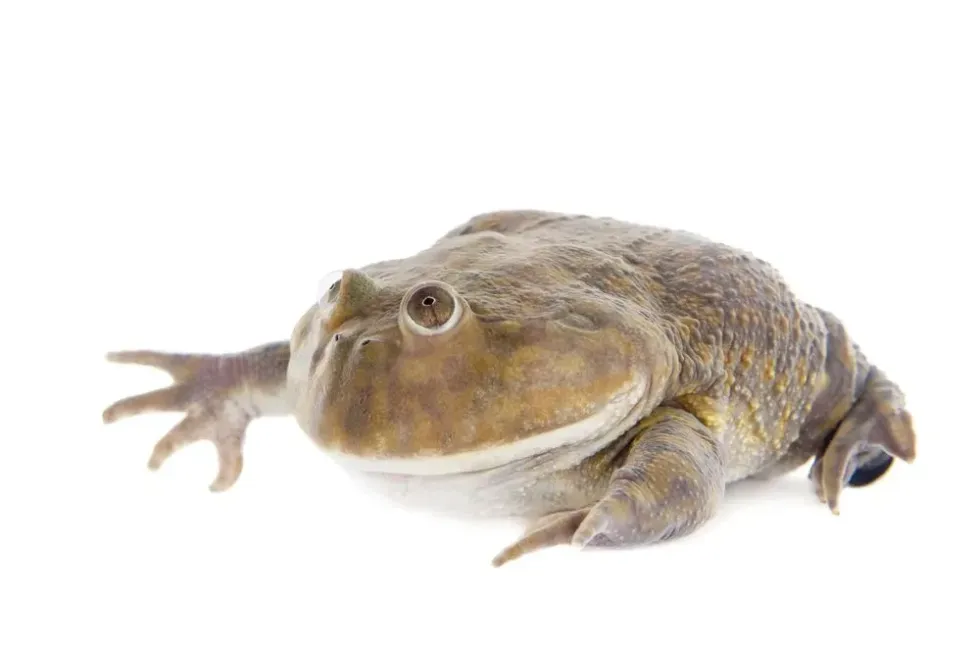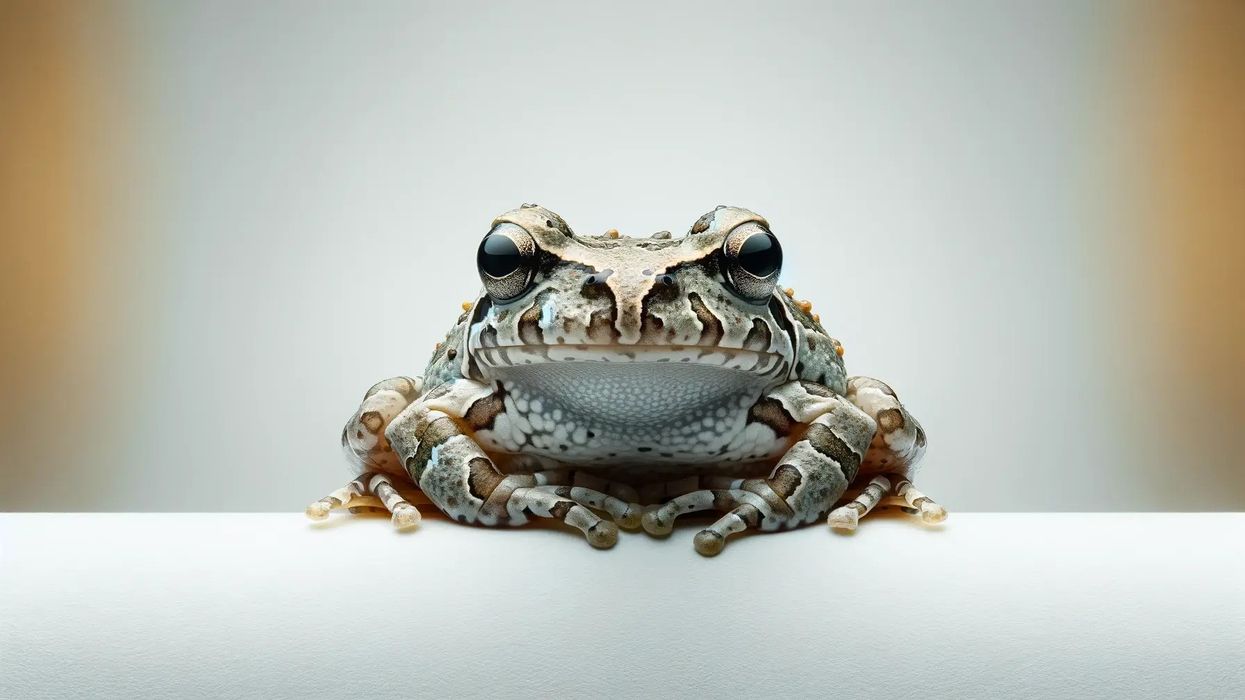Do you want to learn more about frogs? Introduce them to this animal. The interesting facts about this amphibian might catch your attention!
The Budgett's frog is a large amphibian. The family of Ceratophryidae represents a family of horned frogs. The frog has its origin in Gran Chaco. These frogs are sometimes referred to as hippo frogs!
The frog is called the Freddy Krueger frog as well, after the fictional serial killer. The animal is also referred to as escuerzo de agua. The amphibian prefers a semi-aquatic environment.
The tadpoles of this species move very first through the various stages of metamorphosis. These amphibians are cannibalistic predators.
The larval feeding is most unusual. The larvae are known to eat live prey and have digestive tract and craniofacial adaptations for such type of feeding. Naturally, the young of these animals have become an area of interest to researchers in the field of evolutionary biology.
Like reading about these fascinating animals? Want to learn more facts about them? Let's move further and dig in deep!
For more relatable content, check out these African clawed frog facts and bullfrog facts for kids.
Budgett's Frog Interesting Facts
What type of animal is a Budgett's frog?
Budgett's frogs are frogs belonging to the phylum Chordata, order Anura and species L. laevis. The name Lepidobatrachus laevis is the scientific name of the animal.
What class of animal does a Budgett's frog belong to?
The Budgett's frogs belong to the class Amphibia, that is, the animals are amphibians.
How many Budgett's frogs are there in the world?
The Budgett's frogs are found in considerable numbers in the world.
Where does a Budgett's frog live?
The Budgett's frogs are found near the water bodies in Argentina, Bolivia, and Paraguay. The water habitats may be rain-fed or perennial, that is, they may be seasonal or permanent. The frog is pretty sensitive to water changes in its environment.
What is a Budgett's frog's habitat?
The hippo frog is found in the Gran Chaco region of South America. It is found in southeastern parts of Bolivia to western parts of Paraguay and then moving southward into Argentina.
Who do Budgett's frogs live with?
In captivity, these animals are not kept together because of their cannibalistic tendencies.
How long does a Budgett's frog live?
The hippo frog is known to live for 15 to 20 years on average. Most of the time they are known to live for more than five years of age!
How do they reproduce?
The frogs lay 1200-1400 eggs in one clutch. They may lay up to 1500 eggs at a time. Breeding occurs in the wet season.
The male hippo frog calls to attract the attention of females. Breeding takes place fast enough so that the eggs are laid in temporary pools and tadpoles are born before the season of rain ends. The embryo develops within two weeks.
What is their conservation status?
According to the International Union for Conservation of Nature(IUCN), the Lepidobatrachus laevis is classified as an animal of Least Concern. However, data shows that the population of the Lepidobatrachus laevis is decreasing.
Budgett's Frog Fun Facts
What do Budgett's frogs look like?
The wild Budgett's skin is soft and moist and has a pink-gray or olive green coloration. They have a large head and big mouth. The Budgett's frog teeth are in the top row and there are two fangs protruding out of the mouth. The male Budgett's throat is dark blue in color.
The female frog's throat is white or gray. These frogs have a comical appearance. The hind feet of the frogs are webbed. They have eyes at the front. These frogs have flat bodies.
How cute are they?
These frogs are very cute! The animals have a chubby appearance with their large eyes and big mouths! The tadpoles are cute as well!
How do they communicate?
The Lepidobatrachus laevis behavior is interesting. These frogs are known to hiss and squeak. The Budgett's frog scream reflects that it is feeling threatened by an intruder! The screaming Budgett's frog might even bite and draw blood if nothing else works against intruders.
How big is a Budgett's frog?
The Budgett's frogs grow about 3.5 -5 in (10-13 cm) in length. It is larger than other frogs. Females of this species are larger than males.
How fast can a Budgett's frog move?
The frog Lepidobatrachus laevis can move pretty fast!
How much does a Budgett's frog weigh?
A Budgett's frog weighs around half a pound, that is, it weighs around 0.44 lb (0.2 kg).
What are the male and female names of the species?
The adults of the species, that is, the males and the females, do not have different names as such.
What would you call a baby Budgett's frog?
Unlike adults, baby frogs have names. A baby frog is called a tadpole or polliwog!
What do they eat?
The Budgett's frogs are carnivorous amphibians, that is, they eat the meat of other animals. Their diet includes cockroaches, earthworms, crickets, tadpoles, snails, insects, and wax moth caterpillars.
How far can they jump?
The frog Lepidobatrachus laevis can jump considerably high. These frogs are known to jump on intruders.
Would they make a good pet?
The Budgett's frog Lepidobatrachus laevis is very popular as a pet! However, it must be handled by a keeper with considerable experience and knowledge. Budgett's frog care has some specifications to bear in mind.
20 gal or an 18 x 18 x 12 in aquarium is good for a single pet. An aquarium heater is recommended for the pet. These frogs are known to produce considerable amounts of waste.
Cleaning the aquarium enclosure is essential. The substrate in the enclosure consists mainly of clean water. Along with water, rocks can form a part of the substrate in the enclosure as well.
Pebbles should be avoided. The temperature of the tank needs to be regulated as well. Temperature is an important factor.
A very high temperature or very low temperature may adversely affect them. A day-night cycle is important. A 12-hour day-night cycle is to be maintained with proper lighting in the tank.
The prey provided to the animals should be coated in vitamin supplements. Dechlorinated water is also recommended for captive animals. A digital temperature gauge helps in maintaining the correct temperature in the tank.
A digital hygrometer helps in measuring the humidity in the tank. The hippo frog Freddy Krueger needs 60 to 70 % humidity and suitable ventilation. These frogs in captivity may be affected by metabolic bone disease if not taken care of properly.
Did you know...
These frogs are highly intelligent animals. Watching them in an enclosure is captivating and fascinating! They are a nocturnal species and wait in the dark hours of the night, submerged with only their nostrils above the surface for the prey to pass.
The animal is referred to as the Freddy Krueger frog as its fingers are long and it is very aggressive in behavior!
The hippo frog Freddy Krueger needs a lot of water to survive! It loves to stay in the water! Budgett's frogs can breathe underwater. They breathe under the water by absorbing oxygen through their skin. This feature gives them an edge and they are able to stay under water for a long duration.
Budgett's frogs can swim. These frogs are strong swimmers!
The species sexually mature in a year. These tadpoles exhibit cannibalistic nature. Females in captivity should be over two years before they are bred. The sex of these tadpoles cannot be distinguished at birth.
The Budgett's frog gif is popular on the net! It is also called the Wednesday frog! You can find the Budgett's frog for sale on the internet! The Budgett's frog dab is hilarious.
These frogs are known to make use of their fat reserves to last in the winter.
The bite of these frogs is not venomous. However, the bite may hurt so humans should not hold these frogs directly. Captive breeding of these animals in a tank is also an odious task. The tadpoles of this species have explosive growth and may become difficult to be handled.
In Argentina, these frogs are facing a threat. Their habitat is getting destructed because of agriculture. The numbers in Argentina are exhibiting a declining pattern.
Till now, it has not yet been threatened by the pet trade. However, the animal is gaining momentum amongst amphibian collectors.
The frogs are known to absorb all kinds of substances including chemicals in their skin.
Redleg is an infection that may occur in captive animals due to a lack of hygiene.
These frogs tend to scream sometimes even if they are just touched by a human!
They are known to dig the mud! The frogs have a price of around $80 in the commercial market.
Why is it called Budgett's frog?
The frog was first described by John Samuel Budgett in 1899. John Samuel Budgett went to Argentina in search of a lungfish but found the frog! The animal is named after him!
What is unique about a Budgett's frog ?
The head is about half of the frog's total body weight! From the month of November till the month of February in the winter these frogs go into a period of dormancy.
In the animal's natural dwelling place it is the dry season, that is, the pools dry during the period resulting in minimal activity. These frogs are known to sit and wait in the water for long periods of time.
Here at Kidadl, we have carefully created lots of interesting family-friendly animal facts for everyone to discover! For more relatable content, check out these spring peeper facts and blue poison dart frog facts pages.
You can even occupy yourself at home by coloring in one of our free printable Budgett's frog coloring pages.









